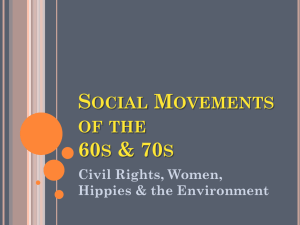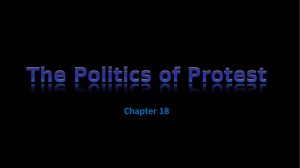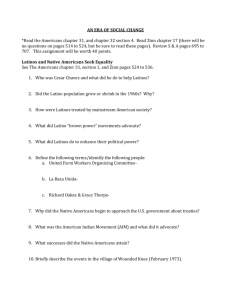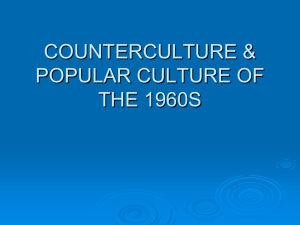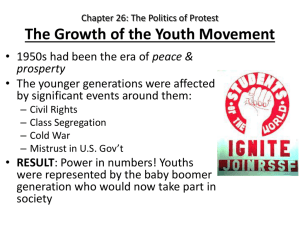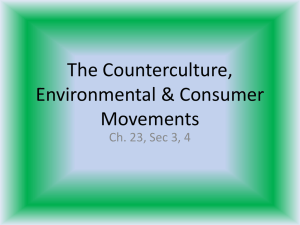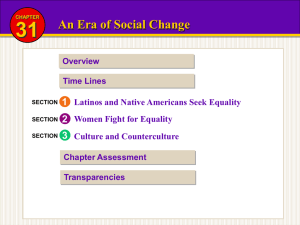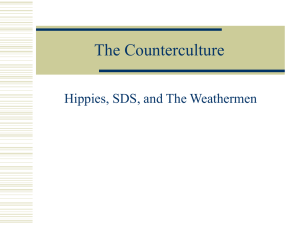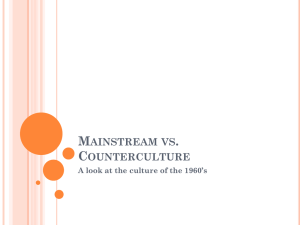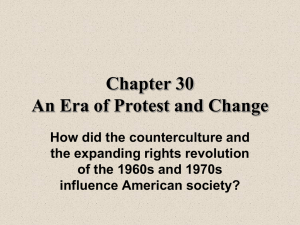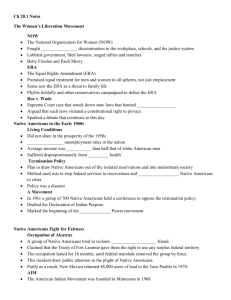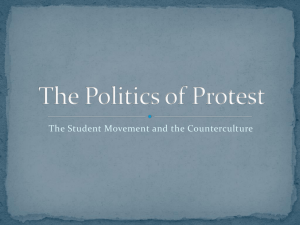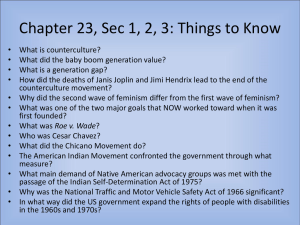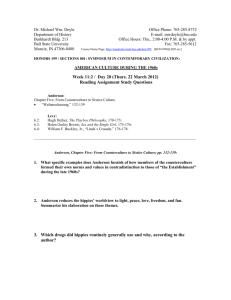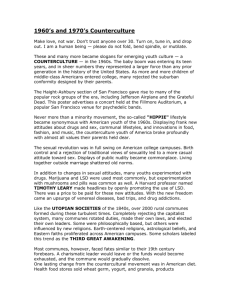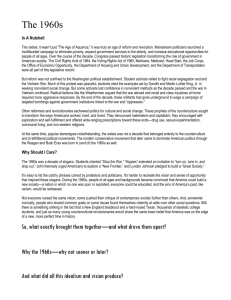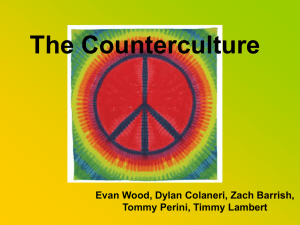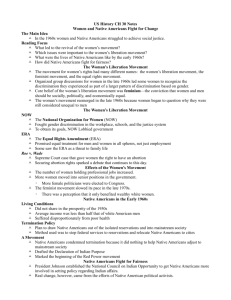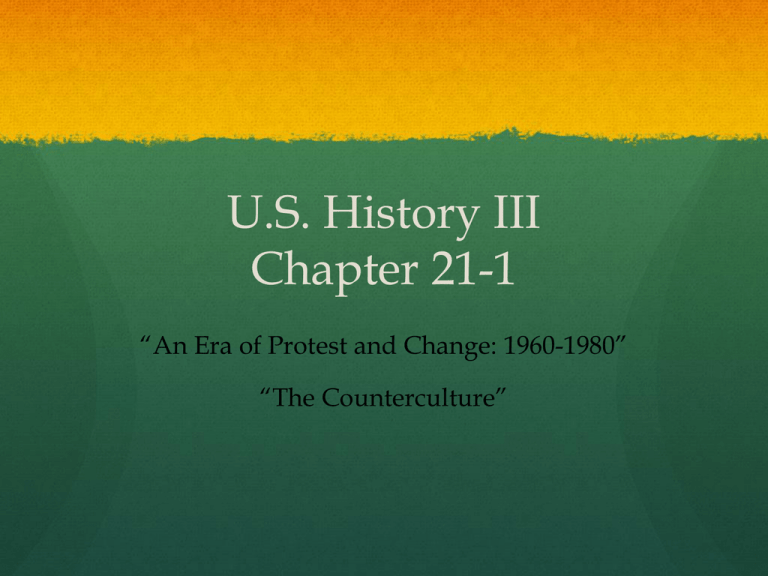
U.S. History III
Chapter 21-1
“An Era of Protest and Change: 1960-1980”
“The Counterculture”
Which Statement do you agree with:
A) The United States is strengthened
by its popular culture and diversity
of values.
B) Popular culture and diversity of
personal values have led to moral
decay in the United States.
Chapter 21.
Introduction
Hippies &
Boomers
1960’s
•
Describe the rise of the counterculture.
•
List the major characteristics of the counterculture.
•
Evaluate the impact of the counterculture on American
values and society.
The COUNTERCULTURE
Rises
generation gap
The baby boomer generation distrusted
tradition and authority.
In the mid-1960s, more than a third of the U.S.
population was under 17. They became a force
for social change.
Defining the
Counterculture:
Music and Art Shape
Youth Culture
The Beatles, a British rock group, changed
the look and lifestyles of the baby boomer
generation.
Folk singers such as Bob Dylan wrote
protest songs to highlight the civil rights
and peace movements.
Andy Warhol: Changed “Pop Art” – Used
paintings of “normal” things to criticize media
In the 1960s, youths rebelled against long-standing
customs in dress, music, and personal behavior.
The counterculture both challenged traditional values
and unleashed a movement to reassert basic values.
The SEXUAL REVOLUTION
The Lovings returned to Virginia, but, sadly,
they enjoyed only a few years together before
Richard was killed in a car accident in 1975.
Mildred survived the crash and lived an additional 33 years.
1953: Playboy makes its debut
1960: The FDA approves the birth control pill
1965: Griswold v. Connecticut legalizes contraception for married couples
1967: Loving v. Virginia makes interracial marriage legal in all states
1972: The first issue of MS. Magazine hits the stand
1972: Eisenstadt v. Baird legalizes contraception for unmarried people
1973: Roe v. Wade makes abortion legal in the U.S.
1987: The AIDS Quilt goes on display at
Washington D.C
Revolution:
•
The sexual revolution called for the separation of sex
from traditional family life.
•
Some people lived together in communes: small
communities of “hippies” who shared common
interests and resources.
•
Many hippies believed that drugs could free the mind.
•
Many hippies sought religious experiences outside
Judeo-Christian traditions.
•
They explored Eastern religions, such as Buddhism, or
sought harmony with nature.
Life in Haight-Asbury
Haight-Ashbury: San
Francisco, CA: 1967, 2,000
people go to this district and
attempt to create their own
“society” (Drugs, Sexual
Promiscuity, Unconventional
Dress/Language/Music, and
Concept of “Shared”
Resources)
In other words, the hippies
defied every middle class value
and replaced it with their own.
Timothy O’Leary: One Time
Harvard Researcher Urged
teens to use drugs to “free the
mind” and “drop out” of
mainstream society
O’Leary began selling LSD
(Acid)
Exploring Different Routes to
Spirituality
The Counterculture rejected
“traditional” religions
(Christianity…etc) and
began to focus on “Eastern
Philosophies” (Buddhism)
The focus of the new
spirituality was on
“harmony with nature”
(Similar to Native
Americans)
Many hippies formed rural
communes and attempted
to live off of the land
The Counterculture Ends
“Peace and Love” descended into
“Paranoia and Violence”
Many become “disillusioned” with
the excesses of the movement and
return to the American “middle
class”
Drug overdoses/addiction rates
skyrocket
Jimi Hendrix and Janis Joplin: Died
of Drug Overdoses
Opportunistic criminals start to prey
on naïve young people (Charles
Manson)
1969: Altamont, California: During a
“peace concert”, a black man was
stabbed to death by members of the
Hell’s Angels Motorcycle Gang
(Gang had been hired for ‘security’)
http://www.youtube.com/watch?v
=OdvCqUguIh8&tracker=False
Effects of the COUNTERCULTURE
on American Society:
Woodstock: 1999
"It was dangerous to be
around. The whole scene was
scary. There were just waves of
hatred bouncing around the
place, (...) It was clear we had
to get out of there.... It was like
a concentration camp. To get
in, you get frisked to make sure
you're not bringing in any
water or food that would
prevent you from buying from
their outrageously priced
booths. You wallow around in
garbage and human waste.
There was a palpable mood of
anger."[14] – Kurt Loder MTV
Chapter 21-2
“The Women’s Rights
Movement”
“A Women’s Movement Arises”
Objectives
•
Analyze how a movement for women’s rights arose in the
1960s.
•
Explain the goals and tactics of the women’s movement.
•
Assess the impact of the women’s movement on American
society.
What led to the rise of the women’s
movement, and what impact did it have
on American society?
After World War II, women gave up their jobs
and returned to their homes to raise families.
In the 1960s and 1970s, however, the women’s movement worked to
attain equality for women and change American life.
Terms and People
•
feminism − the theory of the political, social, and economic equality of
men and women
•
Betty Friedan − author of the groundbreaking book The Feminine
Mystique
•
NOW − the National Organization for Women, which worked for
“true equality for all women”
•
ERA − the Equal Rights Amendment, a proposed Constitutional
amendment to guarantee gender equality under the law
In 1963, journalist and housewife Betty Friedan, wrote
The Feminine Mystique, a book that helped to launch
the feminist movement.
Friedan helped to
establish NOW,
the National Organization
for Women.
NOW attacked
stereotypes and
identified two main
priorities.
•
Passage of the ERA, the Equal Rights
Amendment
•
Protecting women’s reproductive
rights
NOW’s goal was to achieve “true equality for all
women.”
Terms and People (continued)
Gloria Steinem − a feminist leader and writer
who sought to raise the public’s awareness of
gender issues
Phyllis Schlafly − a conservative political activist
who opposed the women’s movement
Roe v. Wade − the controversial Supreme Court
case that legalized abortion
The Equal Rights Amendment was a
proposed Constitutional amendment
to guarantee equality between men and women.
Political conservatives such as
Phyllis Schlafly opposed the ERA, arguing it would hurt
families and allow the military to draft women.
In the end, the ERA narrowly
failed to become part of the
Constitution.
In 1973, the Supreme Court’s decision
in Roe v. Wade granted women
the right to legal abortions.
Before this decision,
most states outlawed
or restricted abortion.
Roe remains a controversial and
divisive decision today.
The long history of struggle for
women’s rights
The struggle for
women’s rights
began with the
Declaration of
Sentiments at
Seneca Falls in
the 1840s.
Women won
the right to vote
in the 1920s,
culminating the
first wave of
feminism.
However, women
made little legal
or social headway
in the decades
that followed.
The civil rights struggles of the 1960s
prompted women to examine their
roles and rights in American society.
•
They rejected the stereotypical view of
women as housewives.
•
They analyzed how society
discriminated against women.
•
They sought equality in jobs and job
training.
This gave rise to the
second wave of feminism.
The women’s rights movement made legal progress in the 1960s
and 1970s.
•
NOW filed many lawsuits with the Equal Employment
Opportunity Commission to stop workplace discrimination.
•
Title IX of the 1972 Higher Education Act banned
discrimination in education.
•
In 1974, the Equal Opportunity Credit act
made it illegal to deny a woman credit
because of her gender.
Women play a larger role in
today’s workforce.
•
Over 60% of women now
work.
•
Medicine, law, accounting,
and other traditionally male
fields now routinely accept
women.
•
However, for the same jobs,
women still earn less than
men.
Chapter 21-3
“The Right’s Revolution
Expands”
“The Latino Population Grows”
A Spanish Speaking
Population
1846-48: Mexican-American War (U.S.
Acquired Texas, Arizona, New Mexico, and
Parts of Nevada, Utah, California)
* Many “Mexican” citizens living in these
areas become American citizens
Late 1800’s and Early 1900’s (Land rights
for Latinos are being threatened)
1942: 4,000,000 Mexican Migrant Workers
come to United States under the bracero
program
1950’s: U.S. Government deported Bra ceros
and other illegal immigrants
1960’s: 400,000 Mexican Immigrants
Arrived
1970’s: 630,000
1980: 1,500,000
Emerging Latino
Communities on the East
Coast
Post WWII: Puerto Ricans,
Dominicans, and Cubans
began immigrating to the
United States
Puerto Ricans came legally
while Cubans and
Dominicans usually risked
their lives on small boats
Tended to settle in NYC and
Miami
Pressing for Equal Right
Cesar Chavez Organizes Farm Workers
Cesar Chavez: Chavez fought for
the rights of farm laborers who
were being exploited for profit
Migrant Farmers: Farmers who
moved from state to state (with the
seasons). Usually faced low wages,
and work conditions, and no
benefits while the companies that
hired them made millions of
dollars
United Farm Workers: Chavez
merged Mexican farmers from
Delano, CA with Filipino farm
laborers to form a union
*The union implemented a strike
and grape boycott
1975- California passed a law
collective bargaining between
growers and union
representatives
Delores Huerta------------
The Chicano Movement
Grows
Chicano Movement- The name given to the
Mexican-American political/social effort that grew
out of the boycott
“brown-power” Jose Angel Gutierrez: La Raza
Unida: Fought for better housing, jobs, “American”
opportunities
1980: 6 Hispanic members sat in Congress
2011: 30 Hispanic members sit in Congress
Native Americans and Asian
Americans Battle Discrimination
American Indian Movement- Chippewa Activists started to
help Native Americans in urban ghettos.
Later, AIM addressed reservation issues, land rights, and selfgovernment issues
1969: Alcatraz Standoff: Members of the Sioux tribe asserted
that the land belonged to them because of a treaty that allowed
Native Americans to have any “abandoned” federal land
1972: Long March: AIM supporters marched from San
Francisco to Washington, D.C. and took control of the Indian
Affairs building
1973: Wounded Knee II: Members of AIM took over the village
of Wounded Knee and a shootout killed 2 members
*The government agreed to investigate reservation conditions
and treaty rights
Native Gains
The Sioux Nation v. United States: The Supreme Court
ruled that the U.S. Government violated the Ft.
Laramie Treaty of 1868
Government ordered to pay Sioux for land taken
Sioux have refused to accept the est. $570,000,000
because they want the Black Hills Land-not money
8 of the 10 poorest counties in America are on
Indian Reservations
Asian Americans Fight
Discrimination
Japanese American Citizen’s League- 1929:
Founded to protect Japanese American Rights
1800’s Chinese Exclusion Act
1900’s Immigration Quota laws limited Asian
immigration
1940’s Japanese families interred while many of
their relatives fought for the U.S. Army
New Rights for Consumers
and the Disabled
Ralph Nader: Unsafe at Any Speed – criticized auto safety
issues- led to the passage of vehicle safety laws (Seat-belts)
Occupational Safety and Health Administration OSHA:
established by Nixon to mandate safe workplace conditions
*Americans tended to still discriminate against people with
physical/mental disabilities
FDR hid that fact that his legs were paralyzed
Eunice Shriver (JFK’s Sister)- Started an athletic camp for kids
with disabilities that eventually became the Special Olympics
Americans with Disabilities Act: Passed to ensure physical,
social, and economic opportunities were available for those
that were disabled. (This echoes the basic American Principle
that everyone deserves OPPORTUNITY)
Chapter 21-4
“The Environmental
Movement”
Environmental Activists Speak Out
Silent Spring Sparks a
Movement
Toxic Waste- poisonous byproduct of human
consumption
Ex. Coal Smog, Acid Rain, Air
Pollution, Water Pollution
1962 Rachel Carson Silent
Spring; discussed the deadly
impact pesticides (DDT) were
having on birds and other
animals
1969: Cuyahoga River,
Cleveland Ohio; Caught fire
because of industrial waste
Inaugurating Earth Day
Earth Day- Nationwide protest
of environmental pollution
Gaylord Nelson- Wisconsin
Senator wanted to “shake up
the establishment…national
issue…”
April 22nd, 1970: 20,000,000
Americans took part in Earth
Day events across the nation.
Sierra Club: Founded by John
Muir in 1892
Wilderness Society: Founded in
1935
*wanted Conservation and stricter
pollution laws (regulations) for
companies
A President Turns
Environmentalist
Nixon: about the 1970’s: “must be the years when America
pays its debts to the past by reclaiming the purity of its air, its
water, and our living environment.” -1969
Environmental Protection Agency: Created in 1970.
Formed to protect the “entire ecological chain”
Clean Air Act: 1970: limit factory/automobile emissions
Clean Water Act: 1973: limited industrial/agricultural
“dumping”
Endangered Species Act: 1973: protected endangered
animals/plants
Nuclear Regulatory Commission: Ford: 1974: Investigated the
dangers of Nuclear Power
Environmental Setbacks
Love Canal- New York
Community had extremely
high rate of birth defects
Toxic chemicals that had been
buried in metal drums were
leaking into the ground water
“…children would return from
play with burns on their hands
and faces.”
Town was abandoned in 1979
and Congress set up
“SUPERFUND” taxes oil and
other polluters to clean up
“dangerous” areas
Love Canal was considered
“safe” in 2004
Three Mile IslandPennsylvania
A overheated nuclear reactor
almost “melted down”
released radiation
Town was evacuated
Building of new nuclear plants
was banned
Questioning Environmental
Regulations
Conservatives
Liberals
Stripped individual
property rights
Property rights does not
take priority over public
health
People would better care of
their own land than
government could
Destroy business and jobs
would be lost to other
countries because of the cost
of “regulations”
Business owners did not
live in same neighborhoods
as factories
Business should pay for
damage done to
environment

